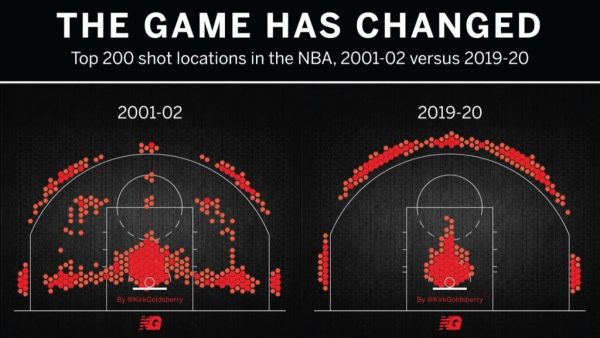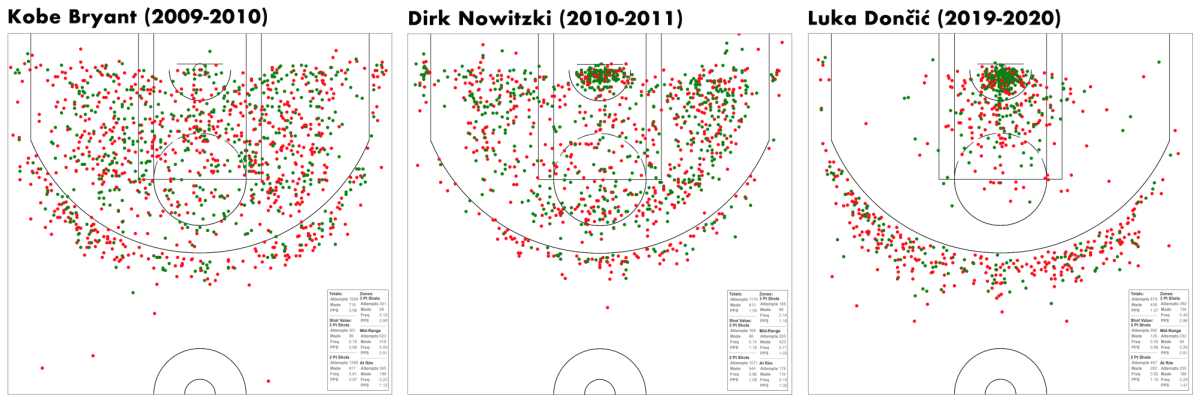Welcome to the National Basketball Association’s new age of prolific scoring, and revel in all its step-back bombing glory. Unless you’re the type of person who misses mid range pull-ups, post-up fade-aways and hand-checking defense. If so, I have some bad news for you.
Karl Anthony Towns scored a Timberwolves franchise record 62 points Jan. 22, the same day Joel Embiid put up an incredible 70 points, a 76ers’ franchise record. Four days later Devin Booker scored 62 points the same day Luka Doncic dropped 73, destroying the Mavericks’ franchise record.
Doncic is only the fourth to reach 73 points. Embiid is the ninth in NBA history to reach 70 points, and he managed to do so in just 36 minutes on the court. It should not be long before they have more company.
Regular season scoring increased league-wide this season. The league’s overall 3-point shooting percentage ended at 36.6%, just behind the record for highest in NBA history at 36.7%. The overall offensive rating of 115.3 ended the season higher than last year’s 114.8, which easily broke the previous record of 112.3, according to basketball-reference.com.
Kevin Durant is currently 10th on the NBA’s all-time scoring list. In his post-game press conference, the same night Embiid scored 70 points, Durant said, “The skill level in this league is insane, and the coaching, the schemes on offense are insane. We’re seeing so many different sets being run for bigs to get threes. Coaches are being way more creative to put their best players in great positions to get those numbers. It’s the peak of basketball.”
The usage rate of star players is on par with the historic numbers, so we know it is not a matter of opportunity. Where are these new offensive schemes coming from?
Quantitative analytics-based approaches on offense are creating this wave of offensive efficiency. Innovators like Mike D’Antoni and his mid-2000s Phoenix Suns teams showed what pace, space and an effective pick and roll could do. D’Antoni joined with Daryl Morey and James Harden in Houston about a decade later and showed that emphasizing layups and three-pointers made offenses much more efficient. The post-up plays and mid-range shots that had been prolific for so long quickly became relatively poor choices for the Rockets.
It was the Golden State Warriors dynasty led by Steve Kerr’s coaching staff and Stephen Curry that finally convinced the rest of the league to embrace the analytical approach. They maintained success with a novel system of floor spacing and off-ball screens with an emphasis on creating open three-point shots. This sustained, mathematically demonstrable system seems to have convinced other teams that they need to embrace a similar approach, albeit one built around their own roster construction. Every team in the league now has an analytics department supporting its coaching staff.

The NBA has been using player tracking in games since 2009 and working with analytics company Second Spectrum since the 2017-18 season. Second Spectrum’s machine-learning software tracks a data point for each player, the referee and the ball. It does this with a series of static cameras in each stadium.
The tracking technology continues to advance at an extreme rate. This season, the NBA announced a multi-year partnership with Sony’s Hawk Eye Innovations, which will track players in real-time in three dimensions. So, rather than tracking the dozen or so data points on the entire court at any given time, the new technology will track 29 points on each player’s body, creating a three-dimensional map in real time, according to Sony.
It doesn’t stop there either. The next product in development from Second Spectrum is called Dragon, “a next-generation technology platform that will track ‘mesh’ data, which aims to synthesize millions of on-court basketball data points.” This will be provided “to all 30 NBA teams who rely on Second Spectrum’s precise machine learning for key basketball insights and decision-making,” according to the company’s press release.
Each of these advances will provide teams with an amount of data orders of magnitude greater than that of its predecessor.
NBA coaching staff now have an unprecedented level of information with which to design their offenses, and that will continue to increase. And as it goes in sports, the defense will always be forced to react to the offense. Offenses will continue to become more effective as analytics and machine learning allow coaches to put players into the best position to capitalize on the greatest amount of skill ever to exist in the game. Roster construction will become more effective as general managers around the league gain access to better data regarding each player’s strengths and weaknesses.
Next time a parent or a grandparent opines about how no one plays defense anymore, or maybe the next 156-152 scoreline tempts you to tilt at some windmills of your own, remember, when you take an elite player with a modern skill set and put that star in a system designed by a coaching staff with access to modern analytics, defenses will continue to struggle to react and offensive records will continue to fall. So, sit back and enjoy the Association’s new age of prolific scoring. It isn’t going anywhere, no matter how hard they play on defense.



